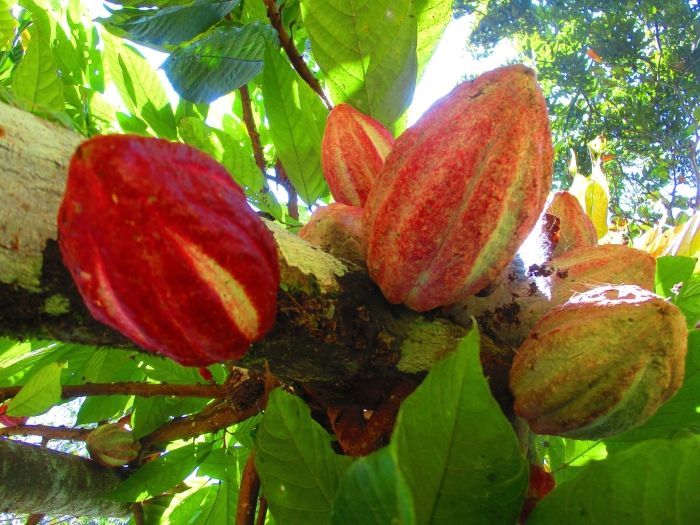Cacao Tree
(Theobroma cacao)
Cacao Tree (Theobroma cacao)
/
/

Jorge Armín Escalante-Pasos
CC BY 4.0
Image By:
Jorge Armín Escalante-Pasos
Recorded By:
Copyright:
CC BY 4.0
Copyright Notice:
Photo by: Jorge Armín Escalante-Pasos | License Type: CC BY 4.0 | License URL: http://creativecommons.org/licenses/by/4.0/ | Rights Holder: Jorge Armín Escalante-Pasos | Publisher: iNaturalist | Date Created: 2019-12-30T11:58:18-08:00 |

























































Estimated Native Range
Summary
Theobroma cacao, commonly known as the cacao tree or cocoa tree, is a small evergreen tree, typically 6–12 m (20–39 ft) tall, native to the tropical rainforests of the Amazon Basin and other areas in South and Central America. It thrives in hot, humid climates and is often found in the understory of the rainforest, where it is protected from direct sunlight by taller trees. The cacao tree is cultivated for its seeds, known as cocoa beans, which are the primary ingredient in chocolate production. The tree’s flowers are small, about 1–2 cm (3⁄8–13⁄16 in) in diameter, with a pink calyx, and exhibit a unique flowering habit called cauliflory, where flowers and fruit develop directly on the trunk and older branches.
The cacao tree is valued for its seeds (cocoa beans) used to produce chocolate liquor, cocoa solids, cocoa butter, and chocolate. Its fruit, the cacao pod, is also notable for its size and color, ripening to a yellow or orange hue. The white pulp surrounding the seeds is utilized in some regions to make beverages and desserts. In cultivation, the cacao tree is often grown in agroforestry systems, which mimic its natural rainforest habitat. It requires protection from wind and benefits from shade, especially when young. The cacao tree prefers well-drained, fertile soils and consistent moisture without waterlogging. It is susceptible to a range of diseases, including witches’ broom, frosty pod rot, and black pod disease, which can significantly impact production. Additionally, the tree is sensitive to changes in temperature and humidity, which can affect fruit development.CC BY-SA 4.0
The cacao tree is valued for its seeds (cocoa beans) used to produce chocolate liquor, cocoa solids, cocoa butter, and chocolate. Its fruit, the cacao pod, is also notable for its size and color, ripening to a yellow or orange hue. The white pulp surrounding the seeds is utilized in some regions to make beverages and desserts. In cultivation, the cacao tree is often grown in agroforestry systems, which mimic its natural rainforest habitat. It requires protection from wind and benefits from shade, especially when young. The cacao tree prefers well-drained, fertile soils and consistent moisture without waterlogging. It is susceptible to a range of diseases, including witches’ broom, frosty pod rot, and black pod disease, which can significantly impact production. Additionally, the tree is sensitive to changes in temperature and humidity, which can affect fruit development.CC BY-SA 4.0
Plant Description
- Plant Type: Tree
- Height: 20-30 feet
- Width: 20-30 feet
- Growth Rate: Moderate
- Flower Color: Cream, Pink
- Flowering Season: Spring, Summer, Fall
- Leaf Retention: Evergreen
Growth Requirements
- Sun: Full Sun, Part Shade
- Water: Medium
- Drainage: Medium, Fast
Common Uses
Edible*Disclaimer: Easyscape's listed plant edibility is for informational use. Always verify the safety and proper identification of any plant before consumption., Fragrant, Showy Flowers
Natural Habitat
Native to the tropical rainforests of the Amazon Basin and other areas in South and Central America, often found in the understory of the rainforest
Other Names
Common Names: Cocoa Tree, Cacau, Cacau Da Mata, Chocolate, Cocoa
Scientific Names: , Theobroma cacao, Theobroma cacao var. leiocarpum, Theobroma cacao f. lacandonense, Theobroma cocao, Cacao minar, Theobroma kalagua, Theobroma kalaguum, Theobroma pentogona, Theobroma salzmannianum
GBIF Accepted Name: Theobroma cacao L.